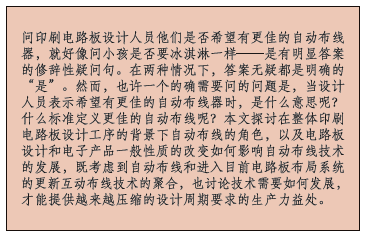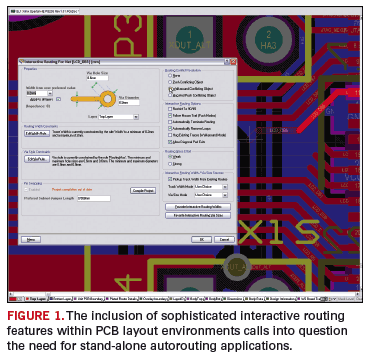
Complex constraints require integrated autorouting that gives the designer the control to deliver productivity gains.
Asking PCB designers whether they would like a better autorouter may seem akin to asking children whether they’d like an ice cream – a rhetorical questions with an obvious answer. Perhaps some better question are what do designers mean when they say they want a better autorouter? What criteria define better autorouting? And how can the benefits of automating the routing process best be delivered to designers?
The answers to these questions are not so straightforward. We need to examine the role of autorouting in the context of the overall PCB design process and look at the changing nature of board design and electronics in general to get to the answers.
It’s a digital world. Electronics started off as an analog discipline. The requirements placed on board design by the technology of the time were modest by today’s standards, and hand routing was an accepted and relatively efficient process, even when done mechanically using tape and tracing paper.
The widespread use of computer-based board design applications through the 1980s allowed significant gains to be made in design efficiency and the complexity and quality of boards that could be produced. Digital technology changed this significantly. It increased signal density and introduced new challenges, such as the need to route groups of eight, 16, 32 or more signals along a single path. This was tedious and repetitive to do manually, even in a computer-based layout package, and as the prevalence and complexity of digital boards increased, board designers began to get bogged down in the digital detail.
It was into this landscape that stand-alone autorouting applications were born and began to be used as a common part of the board design process. As layer and pin counts increased and package pin densities skyrocketed with the advent of surface mount technology, early gridded maze routers gave way to shape-based ‘gridless’ technology. More recently, topological path mapping algorithms have been used to cope with unusual board geometries and component orientations. The 1990s saw the autorouter rise to a level of prominence as a design tool, and the technology has become progressively better and easier to use.
But there is a problem. Traditionally, autorouters have been developed as stand-alone applications. Typical PCB layout software, however, also includes the ability to route connections. So, there is an uneasy relationship that has developed between the two. Over the last decade, we have seen this manifest into a significant convergence of the two design spaces. On the one hand, stand-alone autorouters have acquired features that allow them to be used in a more interactive fashion, as well as the ability to manually route connections within the autorouting space. On the other hand, PCB layout software has become far more intelligent in its approach to routing and the level of automation available in the routing features offered (FIGURE 1).

Converging Paths
This is not a power struggle between autorouters and layout software. Instead, it is a natural reflection of the general convergence of electronics design technologies and the fact that board design is no longer a simple drafting process. Increasingly, it requires a high degree of engineering input in order to achieve an optimal outcome. What once was considered a simple connection, must now be viewed in a wider electrical and physical context to preserve signal integrity. This is driven by both the increasing switching and clock speeds of the circuitry itself and new fabrication technologies such as microvias and high density interconnect boards.
The wider use of large-scale programmable devices in designs also introduces complexities because of the multiple programmable I/O standards available at the pins of these devices, as well as the fluid nature of the signal-to-pin assignments that is the hallmark of these devices (FIGURE 2).

What this all means is that board routing is taking on new and complex dimensions, with a much higher level of interdependency on factors that have traditionally not had to be considered when choosing routing paths. Assessing this intricate interplay of issues is something that humans – engineers at least – are well suited to. The challenge has been to reduce the potential interplay into a tight and formalized set of constraints so that a computer can effectively handle the tradeoffs automatically.
Computers are great at running complex path finding algorithms. Designers are great at analyzing the myriad factors that go into choosing a desired path. The best ‘bang for buck’ in terms of automating the routing process is to combine the strengths of the designer with that of the computer and support the board designer with automation features that assist, rather that take over, the manual routing process. And it is this area of interactive routing that has been the focus of some of the most productive developments in design tools in the last decade.
Features such as intelligent route auto-completion, impedance-controlled routing, the ability to route buses and differential pairs in a single action and guided autorouting (where the designer chooses the approximate path and the router engine does the grunt work of actually laying the traces to comply with the design rules) have enabled designers to cope with the increasing complexity of modern boards without getting bogged down in the minutiae of autorouter set up.
There’s no doubt that better automation of the routing process can save time and increase quality in board design. But the complexity of the constraints surrounding board design today would suggest that integrating autorouting functionality directly into the board design and layout environment and giving designers interactive control over the automation is the best way to deliver productivity gains. It reduces the need to define common constraints in two separate applications, reduces the dangers and time wasted in transferring design data between applications and harnesses a designer’s superior ability to weigh up complex priorities across different design domains.
While standalone autorouters can still be an important part of a board designer’s toolkit in the short term, increasingly, the real value of automation in electronics design lies in facilitating the convergence of the various disciplines that go into creating an electronic product. To do this, the design tools themselves need to converge in order to provide a single model of the overall design. This unified approach is necessary if we are to cope with the increasing complexity inherent in the next generation of electronic products.
So, do you really want a better autorouter? The answer is still yes! But that autorouter will probably be delivered as the interactive routing features of your next-generation electronics design system. PCD&F
Rob Irwin is product marketing manager for Altium and can be reached at This email address is being protected from spambots. You need JavaScript enabled to view it..
















